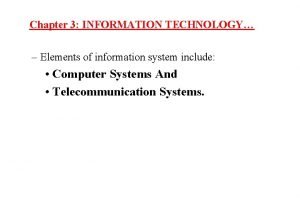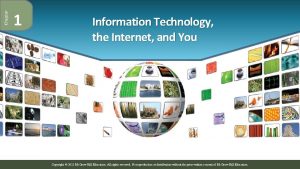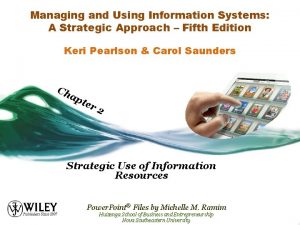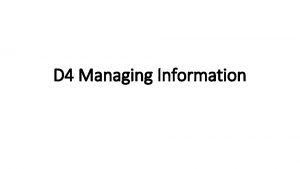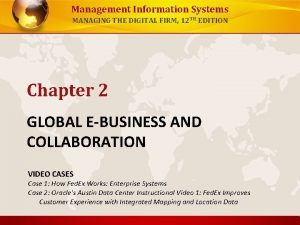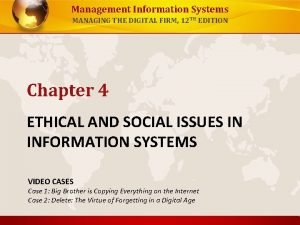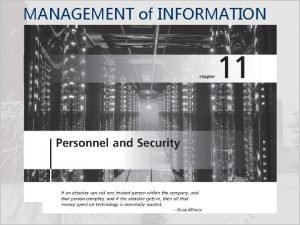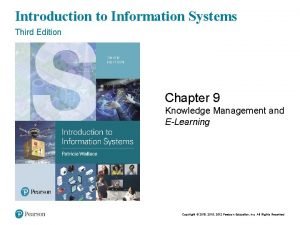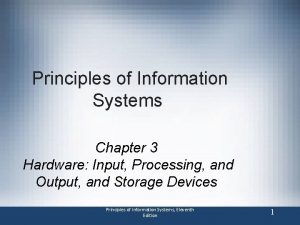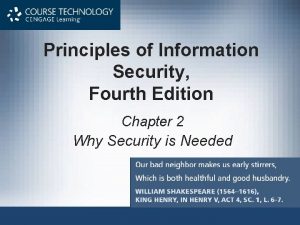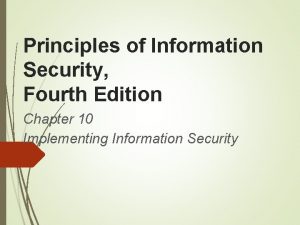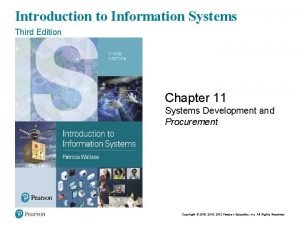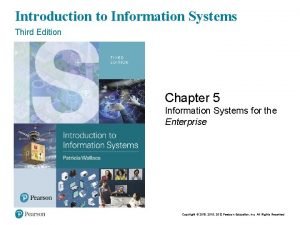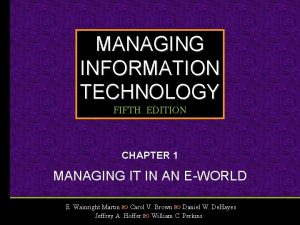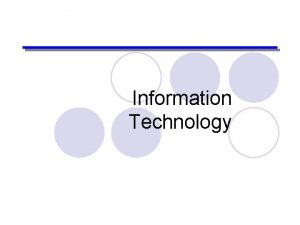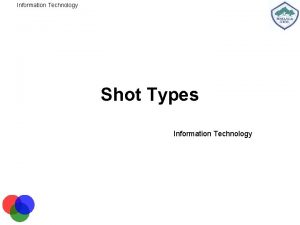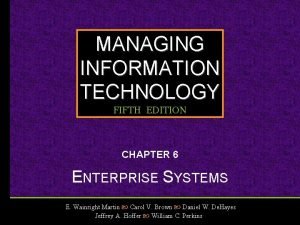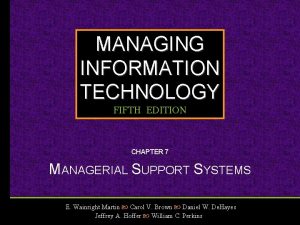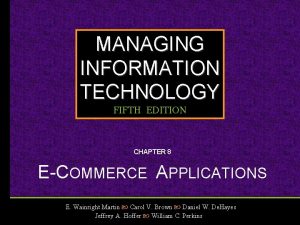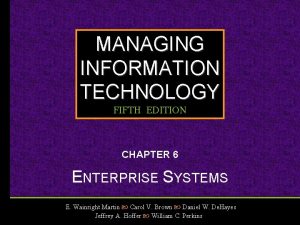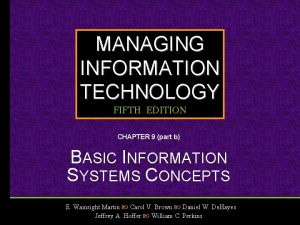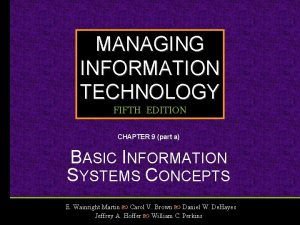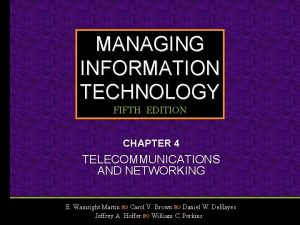Managing Information Technology 6 th Edition CHAPTER 4




















































- Slides: 52

Managing Information Technology 6 th Edition CHAPTER 4 TELECOMMUNICATIONS AND NETWORKING Copyright © 2009 Pearson Education, Inc. Publishing as Prentice Hall 1

IT Building Blocks of Information Technology Hardware Software Network Copyright © 2009 Pearson Education, Inc. Publishing as Prentice Hall Data 2

Overview of Telecommunications and Networking • The electronic linking of geographically dispersed devices required to accomplish telecommunications Telecommunications • Communication at a distance. Also synonymous with data communications, datacom, teleprocessing, telecom, and sometimes networking. Copyright © 2009 Pearson Education, Inc. Publishing as Prentice Hall 3

The Telecommunications Industry • Three major segments – Carriers who sell the service of communication transmission – Equipment vendors who manufacture and sell telecommunications hardware and software – Service Providers who provide access to or services via the Internet Copyright © 2009 Pearson Education, Inc. Publishing as Prentice Hall 4

Telecommunications Industry • AT&T – Largest corporation in industry – In 1984, AT&T split into several companies as a result of a US Department of Justice antitrust lawsuit – Breakup of AT&T has led to innovation through competition – Recent trend towards consolidation in the industry Copyright © 2009 Pearson Education, Inc. Publishing as Prentice Hall 5

Overview of Telecommunications and Networking • Telecommunications and networking are becoming increasingly important to businesses because of decentralization and globalization “ The short answer is that networks will change everything" - Paul Saffo Copyright © 2009 Pearson Education, Inc. Publishing as Prentice Hall 6

Reasons for Networking • Five primary reasons for networking 1. Sharing of technology resources • Prior to networking capabilities, computers could not even share printers!! 2. Sharing of data • Enables virtual teams who can share data • Allows efficient transactions between businesses, their suppliers, their and customers • Some businesses share many terabytes of data per day 3. Distributed data processing and client/server systems 4. Enhanced communications 5. Marketing outreach Copyright © 2009 Pearson Education, Inc. Publishing as Prentice Hall 7

Reasons for Networking • Five primary reasons for networking 1. Sharing of technology resources 2. Sharing of data 3. Distributed data processing and client/server systems • Distributed data processing – • Information processing that uses multiple computers at multiple sites that are tied together through telecommunication lines Client/Server Systems – A type of distributed systems in which the processing power is distributed between a central server and a number of client computers 4. Enhanced communications 5. Marketing outreach Client Transfer of Data Server Copyright © 2009 Pearson Education, Inc. Publishing as Prentice Hall 8

Reasons for Networking • Five primary reasons for networking 1. 2. 3. 4. • • Sharing of technology resources Sharing of data Distributed data processing and client/server systems Enhanced communications Telecommunication networks provide the ability to communication through Email, Bulletin Boards, Blogs, Instant Messaging, Wikis, and Videoconferencing Links between organizations can lead to strategic advantages in terms of business transactions – – 5. SABRE airline reservation system EDI Marketing outreach • Businesses may share data with consumers to advertise or sell their products through a corporate web presence Copyright © 2009 Pearson Education, Inc. Publishing as Prentice Hall 9

Overview of Telecommunications and Networking • A telecommunications network is more than a series of wires or radio waves • Functions of a Telecommunications Network Table 4. 1 Copyright © 2009 Pearson Education, Inc. Publishing as Prentice Hall 10

Analog and Digital Signals Analog Signals • A signal in which some physical property continuously varies across time Digital Signals • A signal that is not a continuous function of time, but rather a series of discrete values that represent ones and zeros Copyright © 2009 Pearson Education, Inc. Publishing as Prentice Hall 11

Analog and Digital Signals • Representation of digital and analog signals Figure 4. 2 Copyright © 2009 Pearson Education, Inc. Publishing as Prentice Hall 12

Analog and Digital Signals • Digital computer data does not naturally mesh with analog transmission; it must be converted from ones and zeros to analog signals • Solutions – Modem (Modulator/Demodulator) Figure 4. 1 – Digital networks • Advantages of lower error rates and higher speeds Copyright © 2009 Pearson Education, Inc. Publishing as Prentice Hall 13

Transmission Speed • Transmission speeds can be measured in several ways Bandwidth • The difference between the highest and lowest frequencies that can be transmitted on a single medium; a measurement of capacity Hertz • Cycles per second Baud • Signals per second Copyright © 2009 Pearson Education, Inc. Publishing as Prentice Hall 14

Telecommunication Lines • Types of Transmission Lines – Private (dedicated) • Advantages – Ensures quality of transmission • Disadvantages – Costly – Switched • Advantages – Less costly • Disadvantages – Message may take many different routes – Quality of transmission may degrade Copyright © 2009 Pearson Education, Inc. Publishing as Prentice Hall 15

Telecommunication Lines • Types of Transmission Lines Simplex • Data can only travel in one direction Half-duplex • Data can travel in both directions, but not simultaneously Full-duplex • Data can travel in both directions at once Copyright © 2009 Pearson Education, Inc. Publishing as Prentice Hall 16

Transmission Media • Twisted Pair – Literally wires that are twisted to reduce interference – Can be shielded (STP) or unshielded (UTP), but the most commonly used is UTP – Commonly used in telephones and LANs Copyright © 2009 Pearson Education, Inc. Publishing as Prentice Hall 17

Transmission Media • Coaxial (Coax) Cable – Baseband • Inexpensive, designed for digital transmission – Broadband • Originally for analog, now used for digital • Commonly used in television cable Figure 4. 3 Copyright © 2009 Pearson Education, Inc. Publishing as Prentice Hall 18

Transmission Media – Wireless • Not strictly a transmission media, but rather a technology in which radio signals are sent through the air • There are many different wireless technologies such as cordless telephones and cellular telephones which are widely used in personal and business communications • We will consider the following wireless technologies in more detail: • Wireless LANs • Microwave – Line of sight • Satellite – Long distances – Line of sight – RFID – Bluetooth Copyright © 2009 Pearson Education, Inc. Publishing as Prentice Hall 19

Transmission Media • Wireless – Wireless LANs • • Growing in popularity Useful when wiring is not possible Slower than some wired solutions Allow mobile devices to connect to network Copyright © 2009 Pearson Education, Inc. Publishing as Prentice Hall 20

Transmission Media • Wireless – Microwave • Widespread use for several decades • Line of sight transmission • Limited to 25 -50 mile distances because of curvature of the earth • Expensive, but less costly than fiber optic cables Copyright © 2009 Pearson Education, Inc. Publishing as Prentice Hall 21

Transmission Media Figure 4. 4 • Wireless – Satellite • Geostationary Earth Orbit (GEO) – Remains stationary relative to earth – Inmarsat service of 11 GEO satellites • Low Earth Orbit (LEO) Copyright © 2009 Pearson Education, Inc. Publishing as Prentice Hall 22

Transmission Media Figure 4. 4 • Wireless – Satellite • Geostationary Earth Orbit (GEO) • Low Earth Orbit (LEO) – Iridium » First major LEO project with 66 satellites » Faced high operating costs and which resulted in a bankruptcy » Mostly military subscribers » Tell us more about these 3 – Globalstar » LEO project with 40 satellites that does not provide global coverage – Teledesic » Ambitious project with original plans to launch 840 satellites » This was later cut to 288 satellites, then 30, and then the program was cancelled Copyright © 2009 Pearson Education, Inc. Publishing as Prentice Hall 23

Transmission Media • Wireless – RFID • Acronym for Radio Frequency Identification • An old technology that became popular in business when Wal-Mart required the use of RFID by some of its suppliers to improve inventory and supply chain management Copyright © 2009 Pearson Education, Inc. Publishing as Prentice Hall 24

Transmission Media • Wireless – RFID • Two Broad Types of RFID – Active – these tags have their own power supply and can transmit messages continuously, on request, or on a schedule » Cost over $1. 00 – Passive – these tags only send a response the RFID reader sends a small radio signal which induces a current » Cost in the $0. 08 - $0. 20 range • Many analysts believe that passive tags must cost only $0. 05 for RFID to be widely adopted Copyright © 2009 Pearson Education, Inc. Publishing as Prentice Hall 25

Transmission Media • Wireless – Bluetooth • Named after Danish King who united Denmark – The technology is intended to unify telecom and computing • Short-range wireless technology • Designed to consume very little electrical power and be produced at a low cost • Found in a growing number of devices such as cell phones, laptops, headsets, keyboards, mice, and home appliances – Over 318 million devices in 2005 used Bluetooth for communication between devices Copyright © 2009 Pearson Education, Inc. Publishing as Prentice Hall 26

Transmission Media • Fiber Optics – Thin fiber of glass – Faster, lighter, and more secure than other media – Large diameter fiber is multimode (multiple light rays at the same time) while smaller diameter is single mode – Smaller diameter fiber has larger capacity due to less light bounces Copyright © 2009 Pearson Education, Inc. Publishing as Prentice Hall 27

Individual Network Access • Internet Service Providers (ISPs) sell access to the Internet • Early, the only way to access the Internet was through a dial-in modem connection • Consumers now have more options including faster broadband connections – Digital Subscriber Line (DSL) is a connection through a telephone company – Cable modem is a connection through a cable television company – Satellite • With one-way service, individuals must obtain uplink service from another provider – Wireless access may be through a municipal carrier or a private company • There are several pricing methods for personal Internet access – Fixed price (usually monthly) • Hotels and airports often offer Internet access for a shorter period (e. g. , 24 hours) – Cost based on usage (data transferred) – Free to consumers, but supported by taxes or advertising Copyright © 2009 Pearson Education, Inc. Publishing as Prentice Hall 28

Network Topology • Network topology refers to the configuration or arrangement of the devices Figure 4. 5 • Bus – All devices are attached to one cable – Single-point failure • Ring • Similar to bus, but ends are attached • Not susceptible to single-point failure • Star • All nodes are attached to central device • Susceptible to failure of central device, but easy to identify cable failure • Tree • Similar to the star, but with a hierarchical structure • Mesh • Devices are to multiple other devices • A failure has little impact on the network • Costly Copyright © 2009 Pearson Education, Inc. Publishing as Prentice Hall 29

Networking Devices • Devices used to implement network topologies Hub • Simple devices that forwards all messages to every device attached to it Wireless Access Point • Central device that connects wireless LAN to other networks Bridge • Connects two LAN segments and only forwards messages that need to go to other segment Switch • A multiport bridge; connects two or more LAN segments Router • Connects two ore more LANs and only forwards messages that go to the other LAN Copyright © 2009 Pearson Education, Inc. Publishing as Prentice Hall 30

Network Types • There are several types of networks • We will consider six types 1. 2. 3. 4. 5. 6. Computer Telecommunications Networks Local Area Networks (LANs) Backbone Networks Wide Area Networks (WANs) The Internet 2 Copyright © 2009 Pearson Education, Inc. Publishing as Prentice Hall 31

Network Types 1. Computer Telecommunications Networks – This was the only type of network until the 1980 s – Commonly used in mainframe architectures Figure 4. 7 Copyright © 2009 Pearson Education, Inc. Publishing as Prentice Hall 32

Network Types 2. Local Area Networks (LANs) – Standards developed by the Institute for Electrical and Electronic Engineering (IEEE) • IEEE 802 is a family of standards for LANs and metropolitan area networks – Five types of LANs in common use today 1. 2. 3. 4. 5. Contention Bus (IEEE 802. 3) Token Bus (IEEE 802. 4) Token Ring (IEEE 802. 5) Wi-Fi (IEEE 802. 11) Wi. MAX (802. 16 e) – We will discuss each of the five types of LANs Copyright © 2009 Pearson Education, Inc. Publishing as Prentice Hall 33

Network Types 2. Local Area Networks (LANs) 1. Contention Bus (IEEE 802. 3) • • Developed by Xerox Usually called Ethernet after the original Xerox version Half-duplex All devices must contend to use – CSMA/CD protocol for collisions 2. 3. 4. 5. Token Bus (IEEE 802. 4) Token Ring (IEEE 802. 5) Wi-Fi (IEEE 802. 11) Wi. MAX (802. 16 e) Copyright © 2009 Pearson Education, Inc. Publishing as Prentice Hall 34

Network Types 2. Local Area Networks (LANs) 1. Contention Bus (IEEE 802. 3) 2. Token Bus (IEEE 802. 4) • A token (special message) is passed among devices • Only the device with the token can transmit a message • Important for Manufacturing Automation Protocol (MAP) 3. Token Ring (IEEE 802. 5) 4. Wi-Fi (IEEE 802. 11) 5. Wi. MAX (802. 16 e) Manufacturing Automation Protocol • A token bus protocol that was developed by General Motors for factory automation Copyright © 2009 Pearson Education, Inc. Publishing as Prentice Hall 35

Network Types 2. Local Area Networks (LANs) 1. Contention Bus (IEEE 802. 3) 2. Token Bus (IEEE 802. 4) 3. Token Ring (IEEE 802. 5) • Developed by IBM • Combination of ring topology with use of tokens (used the same way as in token bus) 4. Wi-Fi (IEEE 802. 11) 5. Wi. MAX (802. 16 e) Copyright © 2009 Pearson Education, Inc. Publishing as Prentice Hall 36

Network Types 2. Local Area Networks (LANs) 1. 2. 3. 4. Contention Bus (IEEE 802. 3) Token Bus (IEEE 802. 4) Token Ring (IEEE 802. 5) Wi-Fi (IEEE 802. 11) • • Short for Wireless Fidelity Most common wireless LAN type Uses a shared Ethernet design Use CSMA/CA Protocol – Similar to CSMA/CD, but with less collisions • Commonly used in offices to supplement wired Ethernet networks or in areas where adding wiring is problematic • Many cities are offering Wi-Fi networks 5. Wi. MAX (802. 16 e) Copyright © 2009 Pearson Education, Inc. Publishing as Prentice Hall 37

Network Types • LANs 1. 2. 3. 4. 5. Contention Bus (IEEE 802. 3) Token Bus (IEEE 802. 4) Token Ring (IEEE 802. 5) Wi-Fi (IEEE 802. 11) Wi. MAX (802. 16 e) • Newest of the network types • Similar to Wi-Fi, but operates over longer distances and at higher speeds • Can use both licensed and non-licensed frequencies • Sprint Nextel are planning to offer their Xohm Wi. MAX service across the US in the 2. 5 GHz radio spectrum – In November 2007, Sprint Nextel abandoned talks of a joint venture with Clearwire, a Wi. MAX provider Copyright © 2009 Pearson Education, Inc. Publishing as Prentice Hall 38

Network Types • Local Area Networks (LANs) – Problems with wireless networks (Wi. Fi and Wi. MAX) • More difficult to secure that other network types • Organizations that offer wireless access to entice customers have problems with noncustomers or unprofitable customers overusing the network • Unauthorized wireless use is also problematic in condos and apartments Copyright © 2009 Pearson Education, Inc. Publishing as Prentice Hall 39

Network Types • Types of Networks Figure 4. 10 3. Backbone Networks • Connect LANs • Key to internetworking Copyright © 2009 Pearson Education, Inc. Publishing as Prentice Hall 40

Network Types 4. Wide Area Networks (WANs) – Similar to LANs, but cover greater distances – We will consider the following three general types of WANs because they each have advantages and disadvantages 1. Switched Circuit 2. Dedicated Circuit 3. Packet-switched Copyright © 2009 Pearson Education, Inc. Publishing as Prentice Hall 41

Network Types 4. Wide Area Networks (WANs) 1. Switched Circuit (or circuit-switched) • A single physical path is temporarily created between two nodes for their exclusive communication • There are most widely available means of implementing a WAN using a switched circuit connection is to use the ordinary telephone network • Advantages – Easy to set up • Disadvantages – Low speed – High error rates • There are two different pricing schemes available for this service – Direct Distance Dialing (DDD) - pay for usage – Wide Area Telephone Service (WATS) - fixed rate Copyright © 2009 Pearson Education, Inc. Publishing as Prentice Hall 42

Network Types 4. Wide Area Networks (WANs) 2. Dedicated Circuit Table 4. 3 These are permanent channels exclusive to the business • Advantages • – High capacity – Low error rates • Disadvantages – Expensive • There are two different types of dedicated circuits – Leased lines are cable, microwave, or fiber connections – Satellite circuits are popular for organizations with many global locations Copyright © 2009 Pearson Education, Inc. Publishing as Prentice Hall 43

Network Types 4. Wide Area Networks (WANs) 3. Packet-switched • Multiple connections exist simultaneously over the same physical circuit • Messages are broken up into packets • Businesses use PADs (Packet assembly/disassembly devices) to connect their networks to a common carrier network • Advantages • Efficient use of network • Can be high capacity • Disadvantages • Packets may arrive in different order or with delay Figure 4. 11 Copyright © 2009 Pearson Education, Inc. Publishing as Prentice Hall 44

Network Types 5. The Internet – Network of networks that use the TCP/IP protocol – Similar to an enormous WAN – 433 million hosts as of January 2007 – Roots in ARPANET and NSFNET • ARPANET (Advanced Research Projects Agency Network) was created by the US Department of Defense • NSFNET (National Science Foundation Network) was created to link supercomputers for research • Each of these were wide scale, packet-switching networks that lead to the creation of the Internet Copyright © 2009 Pearson Education, Inc. Publishing as Prentice Hall 45

Network Types 5. The Internet – Internet Applications Copyright © 2009 Pearson Education, Inc. Publishing as Prentice Hall 46

Network Types 6. Internet 2 – Not-for-profit consortium made up of over 200 universities as well as industry and government partners that develops and deploys advanced network applications and technologies for research and commercial purposes – Goals • Create a leading-edge network capability for the national research community • Enable revolutionary Internet applications based on a much higher-performance Internet than we have today • Ensure the rapid transfer of new network services and applications to the broader Internet community Copyright © 2009 Pearson Education, Inc. Publishing as Prentice Hall 47

Networking Protocols Figure 4. 13 • Network Protocols – An agreed-upon set of rules or conventions governing communication among elements of a network – Open Systems Interconnection (OSI) Reference Model • Skeleton for standards • Movement toward this model stopped with the growth of the Internet Copyright © 2009 Pearson Education, Inc. Publishing as Prentice Hall 48

Networking Protocols • OSI Model – Developed by the International Organization for Standardization (ISO)to outline a standard set of protocols for telecommunications Figure 4. 14 Copyright © 2009 Pearson Education, Inc. Publishing as Prentice Hall 49

Networking Protocols • Transmission Control Protocol/Internet Protocol (TCP/IP) – Created to link different types of networks (e. g. , satellite and ground packet networks) together into a network of networks – Has become de facto standard protocol for networking • TCP is responsible for the reliable and ordered transmission of messages • IP is responsible for routing individual packets based on their individual addresses (IP addresses) – Roughly corresponds to network and transport layers of OSI model Copyright © 2009 Pearson Education, Inc. Publishing as Prentice Hall 50

Networking Crucial to Organizations • Networking and Telecommunications have become necessary for businesses to function – Problems with undersea Internet cables cut in Middle East Copyright © 2009 Pearson Education, Inc. Publishing as Prentice Hall 51

All rights reserved. No part of this publication may be reproduced, stored in a retrieval system, or transmitted, in any form or by any means, electronic, mechanical, photocopying, recording, or otherwise, without the prior written permission of the publisher. Printed in the United States of America. Copyright © 2009 Pearson Education, Inc. Publishing as Prentice Hall 52
 Information technology resource
Information technology resource Information technology project management 9th edition
Information technology project management 9th edition Information technology project management 9th edition ppt
Information technology project management 9th edition ppt Ethics in information technology fourth edition
Ethics in information technology fourth edition Ethics in information technology fourth edition
Ethics in information technology fourth edition Project management quality control
Project management quality control Information technology project management 9th edition
Information technology project management 9th edition Information technology project management 9th edition
Information technology project management 9th edition Managing behavior in organizations 6th edition
Managing behavior in organizations 6th edition Managing front office operations 10th edition
Managing front office operations 10th edition Using mis (10th edition) 10th edition
Using mis (10th edition) 10th edition Mis
Mis Hospitality technology systems
Hospitality technology systems Strategic issues in managing technology and innovation
Strategic issues in managing technology and innovation Information technology chapter 3
Information technology chapter 3 Chapter 1 information technology the internet and you
Chapter 1 information technology the internet and you Chapter 1 information technology the internet and you
Chapter 1 information technology the internet and you Automotive technology sixth edition
Automotive technology sixth edition Automotive technology sixth edition
Automotive technology sixth edition Basic environmental technology 6th edition pdf
Basic environmental technology 6th edition pdf Managing marketing information to gain customer insights
Managing marketing information to gain customer insights Managing and using information systems
Managing and using information systems Managing information between professionals
Managing information between professionals Management information system managing the digital firm
Management information system managing the digital firm Importance of rest
Importance of rest Management information systems managing the digital firm
Management information systems managing the digital firm Managing marketing information
Managing marketing information Failure of supporting utilities and structural collapse
Failure of supporting utilities and structural collapse Introduction to information systems 6th edition
Introduction to information systems 6th edition Fundamentals of information systems 9th edition
Fundamentals of information systems 9th edition Fundamentals of information systems 9th edition
Fundamentals of information systems 9th edition Principles of information systems
Principles of information systems Management of information security 5th edition
Management of information security 5th edition Management information systems 16th edition
Management information systems 16th edition Introduction to information systems 3rd edition
Introduction to information systems 3rd edition Introduction to management information systems 5th edition
Introduction to management information systems 5th edition Principles of management information system
Principles of management information system Principles of information systems 11th edition
Principles of information systems 11th edition Ranked vulnerability risk worksheet
Ranked vulnerability risk worksheet Using financial accounting information 10th edition
Using financial accounting information 10th edition Principles of information security 4th edition
Principles of information security 4th edition Information security
Information security Fundamentals of information systems 9th edition
Fundamentals of information systems 9th edition Essentials of management information systems
Essentials of management information systems Introduction to information systems 3rd edition
Introduction to information systems 3rd edition Fundamentals of information systems 9th edition
Fundamentals of information systems 9th edition Introduction to information systems 3rd edition
Introduction to information systems 3rd edition Chapter 1 managing risk when driving
Chapter 1 managing risk when driving Chapter 8 managing stress and anxiety
Chapter 8 managing stress and anxiety Chapter 4 managing stress and coping with loss
Chapter 4 managing stress and coping with loss Biomechanical drivers ed
Biomechanical drivers ed Chapter 8 managing distractions answers
Chapter 8 managing distractions answers Chapter 6 managing weight and body composition
Chapter 6 managing weight and body composition














